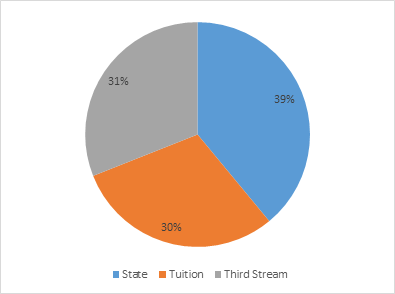A couple of weeks ago, I laid out some of the basic issues in South African higher education. Today, I want to focus on two particular sets of institutional issues that I think make the country’s policy landscape quite distinctive.
The first area has to do with how institutions raise income. Sub-Saharan African countries tend to fall into two groups: those that are over-reliant on government funding (most of Francophone and Lusophone Africa), and those that are reliant on private fees paid mainly to private institutions or through dual-track tuition systems at public universities (most of Anglophone Africa, especially East Africa). What you don’t tend to see in Africa are universities relying on self-generated non-fee income to fund themselves. Here’s where South African universities’ money comes from:
Figure 1: South African Universities’ Income by Source (Source: Vital Stats, Public Higher Education 2012, Council on Higher Education, South Africa)
One could quibble around the edges with this: if you count all the money government spends on student aid, the state stream is considerably bigger (and the tuition stream smaller), but the really amazing thing is the third-stream income, which comes neither from government or students. At 31%, it’s pretty much the highest percentage of anywhere in the world.
Figure 2: Third-Stream Income as a Percentage of Total University Income, South Africa and Selected OECD Countries (Source: Vital Stats, OECD Education at a Glance 2104, Table B3.1)
Interestingly, South African institutions are achieving this without a significant tradition of charitable giving. This isn’t a US private college situation where the money is all coming from endowments; according to a 2009 survey, endowments account for only about 11% of the money. About a third of it comes from contracts, and over 55% of it comes from things like sales of service.
Sure, the big old (sotto voce: “white”) institutions like Wits and UCT do better on this measure than others (48% and 40%, respectively), but even the poorest institutions (the universities of technology) make 15% of their income this way – same as Japan and Australia. That’s evidence of a very high degree of entrepreneurialism. Admirable.
The other interesting thing about South African institutions at the moment is the attention being paid to curriculum. As I noted previously, South Africa is plagued by drop-outs; only about 50% of starters complete their studies. The culprit, by general agreement, is under-preparedness of students; there is an articulation gap between secondary and post-secondary (which makes initial transitions difficult) and curricula in many subjects contain transition points that takes for granted certain knowledge and abilities that all students may not have.
(Interestingly, while there are wide gaps in primary and secondary schooling available to Africans and whites, the dropout problem is only partly related to this. Though there are differences in completion rates by “population group” [the preferred way to say “race” in South Africa] they actually aren’t that wide: 6-year graduation rates for Africans are 47%, compared to 59% for whites. Compare that to the US, where the rates are 40% for Blacks and 62% for whites.)
So, your country’s system has an articulation problem, a transition problem and – to top it off – worries about how well current education is preparing students for the future labour market. What do you do? Well, the current preferred solution to this problem (outlined in this document) is to lengthen periods of study: that is, to move from a system of mostly three-year degrees to a system of mostly four-year degrees. And this isn’t simply a matter of adding a base foundation year – what’s being contemplated is a wholesale re-writing of curricula from the ground-up. In some ways, it’s a more daunting task than the Bologna curriculum re-write, which often involved little more than slicing five-year degrees into a three-year Bachelor’s degree, and a two-year Master’s.
It’s not entirely clear whether this will happen – cost implications are significant, and there isn’t a lot of money in the kitty in Pretoria. But having gone through our own debate about degree-lengths a few years ago, it’s refreshing to see a discussion driven by desired learning outcomes and curriculum analysis rather than vigorous hand-waving from politicians.
South African universities have taken extraordinary measures to close the funding gap; if they were able to take similarly bold measures to tackle the attainment gap, the payoff would be profound.



 Tweet this post
Tweet this post
